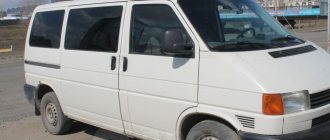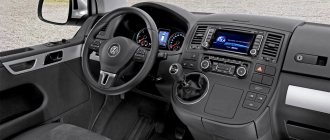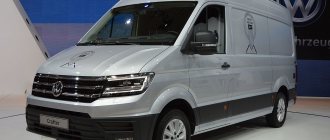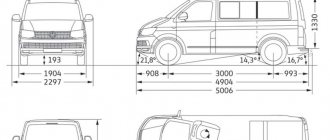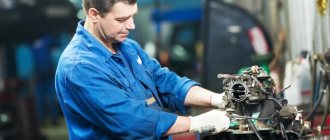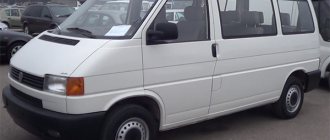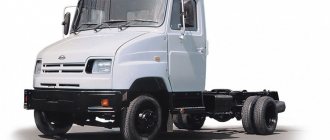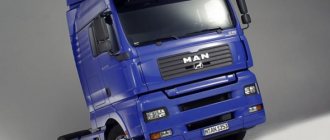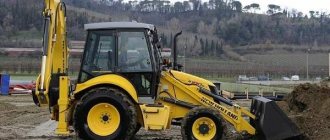Home Brands Volkswagen Volkswagen Transporter T2
The Volkswagen Transporter T2 car has an interesting history of creation. Of course, because this car has captivated the whole world. The birth occurred in 1967. German manufacturers gave Volkswagen a simple appearance. But it pays off in terms of parameters and performance capabilities. Plus, the functionality and application of the car is also worthy of attention. Let's take a closer look at the history of the car and its important characteristics.
Car history
The second generation of the Transporter appeared only in 1967. There were no major alterations, since by this time its predecessor had already gained a reputation as a perfect machine.
The T1's split windshield was made one-piece, adding comfort to the driver's seat. We worked with the rear suspension and expanded the range of engines - they became more powerful. Sliding doors appeared as standard.
One of the secrets to the popularity of the conveyor is the continuous improvement of the design. Just a year after the start of production, the brakes became dual-circuit, and three years later additional disc brakes were added to them.
They didn’t forget about the engine - since 1972 it has become more compact, and power has gradually increased to 50-70 hp. Then three-speed automatic transmissions appeared. Angularity began to appear in the lines of the body.
T2 became a little larger, and the driving characteristics were no worse than those of passenger cars. It was still a roomy cargo horse because it retained its ingenious axle weight distribution.
Volkswagen T2 modifications are a whole list. Mobile homes on wheels have become especially widespread. The beginning was made already during the release of the first model - it was a camper with a raised roof. Based on T2, mass production of mobile homes began - with furniture, a kitchenette and even its own covered terrace (folding awning).
The transporter was produced for 13 years - only in Germany. After 1971, an improved version appeared, designated T2b.
It was this model that lasted in Brazil until 2013 (with additions and improvements). But the main parts remained original. Only in 2006 did they begin to replace air-cooled engines with 79 hp in-line engines.
This led to changes in the front of the car - a false radiator appeared.
Not for hippies and free love: the experience of owning a Volkswagen T2
Dossier
Car:
Volkswagen T2 B, produced October 11, 1976. Purchased for restoration for 400,000 rubles. It is in as close to stock condition as possible for a car of that era that is driven regularly and not kept in a collection.
Owner:
Yuri Lukinov, 30 years old, lives in the city of Dolgoprudny, works as an IT analyst in a bank. He loves to travel around Europe in his T2 and really dislikes the cliched association of old Transporters with hippies and all their manifestations - pacifics, weed, freelove and the like.
- In 2013, I accidentally saw one of these buses in one of the Moscow courtyards - and it hit me: how did I live before without such a car?! Natural love at first sight! – Yuri recalls with a laugh the history of the car’s appearance:
- I started digging and searching, found out who restored that car, and through this person I joined the “bus dealers” crowd, met this cheerful and very friendly public and began looking for a “bus driver” for myself. This is where the difficulties began... At the beginning of the 2000s, T2 could easily be bought for fifty thousand in a condition that did not even require welding or painting... Well, at least urgently. But then these cars became fashionable, everyone was snapped up, and the prices jumped sharply... Moreover, there was such a rush that many people contacted their friends in the traffic police so that they would “break through” who registered such a car in the city in order to find people and offer to buy them car...
It’s difficult to say what served as the catalyst for fashion - maybe a fad finally arrived from Europe, maybe it just coincided that a certain number of cars were restored, they began to drive, flash on the streets and at retro events, they were noticed and, as they say, we tried it out... Therefore, when three years ago I decided to get an old-school Transporter, I found myself, as they say, in a head-scratcher - there were very few offers, and the prices were high.
I looked at one bus in St. Petersburg - it was interesting for its good condition, although it was all-metal, but I had to refuse it due to problems with documents. Then I found another T2 in Sochi, and even rashly made a deposit, but future colleagues from the community of owners dissuaded me - it was too rotten, although it came with two engines... They convinced me that even for the 50,000 that they wanted for it, I could take it it wasn’t worth it... And a few months later a friend from the community called and said that one of his friends was selling the bus I needed. He once brought it from the Krasnodar Territory in mediocre condition with plans for restoration. But after restoring the Air Beetle he had on the Transporter, his enthusiasm waned, after which he decided to get rid of the car.
Friends and parents grabbed their heads and unanimously dissuaded them - they say, for those 400,000 rubles that were asked for an elderly “German”, you could take a lively three-year-old Focus and just drive it every day, without knowing much grief... But I was adamant, and T2 became mine. Having tormented myself with the endless steering of the car, which did not hold the road due to the dead suspension, I dragged myself in a minibus from Moscow to Dolgoprudny and fell asleep like a log. The next morning I looked out the window at the “new car” standing at the entrance, and I felt somehow sad - damn it, why did I do this?! However, after the suspension was shaken up, I was surprised to discover that the car was able to behave adequately on the road, and when on the first trip I received countless “likes” and positive expressions, I immediately realized that I had done everything right!
Having understood the design of the car and thoroughly repaired it, I realized that in terms of reliability, you can trust the Transporter - and even more than the 2002 Civic, which was nevertheless purchased as an everyday traveling car, so as not to kill the rarity too much. Therefore, in 2016, I decided to take a big trip: the car was forty years old, and I had to pamper it by taking it to visit my homeland. The three of us set off, with two friends and classmates - at first it was a little scary, but after we covered the Moscow-Brest stage in one go, we relaxed and got to the plant in Wolfsburg without incident! As a result, summer long-distance voyages have become a tradition - as a rule, they fit in with European festivals of “air coolers” - get-togethers of lovers of old cars with air-cooled engines, mainly, of course, Zhukovs and Transporters. These are very atmospheric events, imbued with the spirit of goodwill and fun - for the sake of this spirit, many people buy such cars!
1 / 2
2 / 2
Outside
Only their owners and ardent fans understand the nuances of old-school Transporters, while most ordinary people will most likely remember from the films only the first-generation bus with that expressive triangular “nose”, which some vulgars call “cowards on the head.” T2, let's be honest, is not as extravagant in appearance as T1, and therefore some owners even draw those very “panties” on their faces. However, our minibus is not damaged by such art, it is very close to stock condition and has even returned to its original color!
- When I bought the car, it was repainted by one of the previous owners in a certain yellow-beige color, says the owner:
- But by the body number we were able to find out the factory equipment, color and even the first buyer of the car on www.vw-mplate.com. It turned out that my bus originally came off the assembly line in two colors: blue “reef blue” on the bottom, milky “pastel white” on top, and now the original color has been restored. And the first owner of the car was the Audi plant: the bus transported employees around the territory of the enterprise - in fact, it worked as a minibus.
1 / 2
2 / 2
The retractable footrest is connected to the interior sliding door by rods and, after closing the door, is partially hidden under the belly. This is one of the hallmarks of the deluxe trim, along with moldings and some chrome trim.
1 / 2
2 / 2
The car plant logo on the face of T2 is not as huge as it was on T1, but also very impressive:
1 / 3
2 / 3
3 / 3
Inside
The interior of the car is ascetic to the point of horror - flat surfaces covered with black leatherette, simple bench seats without any hint of adjustment or any kind of support - the concept of a mass-produced and inexpensive car of that era put utilitarianism at the forefront.
The copy of T2 purchased by Yuri turned out to be interesting for the middle row of seats in the cabin, which is very rare for these buses, because it is rarely preserved. The owners almost always removed the middle “benches” to increase space for luggage and threw them somewhere in the barn or attic, where they happily turned into dust. Finding live seats here is very difficult, and abroad it’s not cheap. For example, in the States this element costs about one and a half thousand dollars...
The front driver's row has three seats, although, of course, it is a bit cramped for three adults. The seats are just as laconic and uncomplicated - looking at them, it’s hard to imagine the thousands of kilometers easily covered by this and many other “retrobuses”! However, a bunch of magnetic badges that decorate the dashboard (they are magnetized to it because the dashboard is made of iron!) are there for a reason - they all mark the numerous festival and tourist outings that Yuri has already managed to make on his favorite.
1 / 3
2 / 3
3 / 3
There are a lot of autographs on the driver's door - at one of the festivals the entire Leningrad group, of which the owner of the car is a big fan, signed it.
Iron
Engine T2 - opposed, air-cooled, 1.8 liters and 75 hp. This is a “car mechanic’s nightmare,” because this arrangement of the unit is very inconvenient for repairs. It comes to something a little more complicated than replacing spark plugs and an alternator belt or adjusting a carburetor - you have to remove the entire engine... In the original, the 1.8-liter engine had two carburetors (there was one on the 1.6), but adjusting them and synchronizing them is fine - that's all. another quest. As a result, the owner followed the guru's advice and installed an intake spider under a single Weber carburetor. Also, to increase reliability on long trips, a Pierburg low-pressure electric fuel pump was installed instead of the standard mechanical diaphragm one, located at the bottom, in a hard-to-reach place.
1 / 2
2 / 2
Like any car with an air vent, the heating system is a weak point. Normally, the flow of incoming air can be directed onto the glass and through the pipes in the front doors to the rear passengers into the cabin. But this is only cold outside air. Warm air flows through special heat exchangers located around the exhaust tract. Air was taken in through gills in the rear of the body and forced by a fan through heat exchangers into the cabin through a hatch in the floor. Part of the air went further and entered a pipe standing vertically at the feet between the driver and the front passenger, through which the warm air diverged into streams into the driver’s feet and onto the glass. Warm air entered the cabin through an intake duct from the main air line from the heat exchangers. However, on this T2 instance the entire system was pretty rotten, and restoring it turned out to be completely irrational. As a result, the owner installed a stove from a Volkswagen T3 - this is a flat design located under the bottom and runs on gasoline, like the Zaporozhets. The stove was embedded into the standard air duct system, and it harmoniously fit into the car’s equipment.
The gearbox, of course, is manual, four-speed. On the gearbox handle you can see a sliding ring - this is the so-called “shifter”; in the T2 era it was fashionable to install such ones. The fact is that the long rods to the box located at the back went in a pipe under the floor, resting on supporting plastic bushings called “shuttlecocks”. When they became loose, it became difficult to engage reverse gear, and changing the shuttlecocks was difficult and expensive - it was necessary to remove the motor and gearbox... Therefore, to simplify gear shifting, the owners replaced the original handles with non-standard ones, with a system for engaging reverse gear through a ring.
In move
It is clear that the owner is accustomed to his car, and driving it does not present any difficulties for him. Moreover, against the backdrop of many long-distance trips already made and the sea of positivity that the car brings him. But how will a 40-year-old person who is unusual feel on a bus? Let's check!
There were no problems getting behind the wheel even if I was tall; the cramped space didn’t feel oppressive. But the landing itself is still a test. The seat is “stool-like”, the plane of the steering wheel is almost horizontal, like on any bus, and there is a fair amount of play. The steering wheel makes three and a quarter turns from lock to lock. It rotates a little stiffly, but tolerably. It’s worse with the pedals... They grow out of the floor, their rods are high, and even strongly inclined towards the driver. To put your feet on them, you have to pull your feet high towards you - in any modern car, the landing and position of the feet on the pedals are completely different, much more harmonious for human physiology. The travel of the pedals to the stop at both the gas and the brake, by the way, is unexpectedly short - something else was expected. The grip of the brakes is also quite good - there are discs at the front and there is a vacuum booster, which was not present on the pre-restyling “A” modification.
The car is maneuverable and turns, which is very useful in crowded urban conditions: the “nose” is short, the front axle is located directly under the driver’s seat - approximately the same sensations were felt from the successor to the T2, the last rear-engine VW Transporter T3. For the city, both speed and dynamic characteristics are enough without straining - just start in first gear, second - up to 40 km/h, third - up to 60 km/h, and then fourth - unless, of course, you have to brake... In principle , in the city, if it’s not on weekends, there’s no need to engage fourth gear. On the highway, the comfortable speed is 80 km/h. Although 100 km/h is tolerable, and 120 can be reached downhill. Moreover, even on a bad highway, the car on small 14-inch wheels travels comfortably at cruising speed - the torsion bar suspension with torsional elements swallows potholes and works very softly!
Model history
The second generation of the Volkswagen Transporter, the car that actually formed the minibus class, consolidated the incredible success of the first and was produced from 1967 to 1979. The Volkswagen T2 holds one of the records for automobile longevity: after production of the car ceased in its homeland, Germany, production continued at the Volkswagen plant in Sao Paulo, Brazil until 2013 - that is, the T2 did not leave the assembly line for 46 years! In 2014, the last copy of the classic Kombi minivan (under that name it was produced in South America) was brought to the VW Commercial Vehicle Museum in Hannover in a special “Last Edition” version, marking the end of the T2 era.
1 / 3
2 / 3
3 / 3
Specifications
There have been no major changes, with the T2 considered a better option than its predecessor.
- The appearance remained recognizable.
- The chassis remains the same, but the rear suspension has been worked on and strengthened.
- The engine was replaced with a more powerful unit.
- Ground clearance – 19 cm.
- The salon has become more spacious.
- Solid windshield. Glazing allows for visibility.
- Sliding doors, which will now become an integral part of the conveyor.
- The brakes have become more advanced and reliable. Now timely braking is provided by dual-circuit systems. Disc brakes are installed on the front wheels - more powerful than drum brakes on the rear. This prevents skidding even during sudden braking. All machines are equipped with a hydraulic drive with a vacuum booster. The rear brakes are equipped with an adjuster.
- The driver's seat has become adjustable.
- Rack and pinion steering, with power steering (on some models). Located almost horizontally.
- There was heating in the cabin. The first attempts to make the interior warm were carried out for the first generation, but then the heating system was ordered separately. Heated models were exported to northern countries. Now heating has become a reality in models with an engine that is cooled by liquid.
Read also Volkswagen Touareg 2008: review of the improved model of the first generation of the line
Engine
Significant changes took place in 1972. A flat engine with a volume of 1.7 liters and a power of 66 hp appeared; it was still installed in the stern.
The installation of a 1.6 and 2 liter engine with 50-70 hp has become standard.
checkpoint
Along with the updated engine, an optional 3-speed automatic transmission appeared.
In parallel with the improvement of the engine, the capabilities of the gearbox expanded. Since 1975, 4- and 5-stage gearboxes have been installed.
The clutch, like on most modern cars, is a dry single-plate clutch.
Suspension
Completely independent. Front – system of upper and lower arms.
Volkswagen Transporter powertrains
| Automobile model | Installed motors |
| 1st generation (T1) | |
| Volkswagen Transporter 1950 | HE HF |
| 2nd generation (T2) | |
| Volkswagen Transporter 1967 | CU CT HF |
| 3rd generation (T3) | |
| Volkswagen Transporter 1979 | CT CU DF DG SP DH GW DJ MV SR SS CS JX KY |
| 4th generation (T4) | |
| Volkswagen Transporter 1990 | PD AAC AAF ACU AEU AET APL AVT AES AMV 1X ABL AAB AJA AJT AYY ACV AUF AXL AYC AHY AXG |
| 5th generation (T5) | |
| Volkswagen Transporter 2003 | AXA BDL BRR AXC BRS AXB AXD BNZ AX BPC |
| Volkswagen Transporter restyling 2009 | CAAA CAAB CCHA CAAC CFCA AXA CJKB CJKA |
| 6th generation (T6) | |
| Volkswagen Transporter 2015 | CAAB CCHA CAAC CFCA CJKB |
| Volkswagen Transporter restyling 2019 | CJKB |
Volkswagen T2 review
The car was produced for a long time, constantly being improved. T2 versions and configurations were in demand not only in the field of commercial transportation. They were bought as a means of transportation for family and private use.
VW T2 configurations
The transporter was produced in several modifications - there are many more of them than in the first generation:
- fully enclosed truck
- minibus for 9 people
- cargo platform with single or double cab
- truck with wooden platforms
- series of special purpose vehicles (police, armored, medical vehicles)
- car with hinged doors on the side.
Each modification had configuration options. Some configurations were produced from generation to generation, constantly being improved.
Maintainability of power units
Most engines of 1-4 generations of Volkswagen Transporter have good maintainability. They have a cast iron cylinder block with a large margin of safety. After capital, it is possible to restore the original resource by 75-85%. It is easy to find repair kits for popular and not too old engines on sale.
DG engine repair process
Pistons
The engines of cars of the fifth and sixth generations have acquired a large number of electronics. This makes them difficult to repair. Officially, many engines are considered disposable. Despite this, most car repair shops undertake the repair of Volkswagen Transporter power units. Nevertheless, in case of serious malfunctions, it is better to give preference not to restoring the original engine, but to purchasing a contract one.
Contract engine
Advantages and disadvantages
The Volkswagen Transporter T2, like its predecessor, is distinguished by its laconicism and minimalism (with the exception of luxury models).
- What is captivating about the car is its simplicity. This is a car that will become a reliable hard worker and will work, regardless of the year of manufacture. You can always find suitable spare parts. It’s expensive to order relatives, but at flea markets, Avito, and in social network groups you can find a large number of used parts.
- This is a passenger chassis, so many parts can be taken from passenger cars. In many cases, spare parts from Soviet cars are suitable.
- T2 can be loaded to the maximum, but strictly no more. It will maintain balance and poise because the chassis is based on a precisely thought-out weight distribution system.
- The suspension will last almost forever.
- In the second version, interior heating appeared.
On the forums you can find descriptions of problems, but there are no complaints about the concern’s shortcomings. The owners of this car are always satisfied with the hardworking bull.
- The disadvantage is the motor noise. But in reality, no attention was paid to this in the last millennium.
- What is unusual and difficult for many is the orientation of the steering wheel - it is installed, like on buses, almost horizontally.
- Shifting gears is not easy to master. The lever is located low and has a large amplitude.
Read also Legend: Volkswagen Passat B4
Popular motors
The early generations of the Volkswagen Transporter are quite old. Since most of the cars were used for commercial purposes, it is extremely difficult to find the original engine on them. The popular powerplants CT, DG, DF and CS are well preserved on used cars. These internal combustion engines are often found on other models of the brand.
DG engine
The Volkswagen Transporter became popular with the CFCA. This is a diesel power unit with high power. Its torque is sufficient to overcome inclines when loaded. Drivers love the CFCA engine for its ease of overtaking, thanks to the presence of power reserves even when driving at high speeds.
Diesel CFCA
Another popular engine on the VW Transporter is the CAAC. It has found application on modern generations of cars. The power unit can boast of compliance with all environmental standards. The motor has good efficiency.
CAAC powerplant
In addition to diesel engines on the Volkswagen Transporter, gasoline power units, for example, CJKA and CJKB, are also popular. The installations have excellent prospects for increasing power. At the same time, internal combustion engines have a long service life and a huge margin of safety. During operation, gasoline engines create less vibration than diesel engines.
Engine CJKA
Motor CJKB
Another popular gasoline internal combustion engine is AXA. The motor perfectly combines reliability and durability. Its maintenance is not difficult, and the number of emergency repairs is kept to a minimum. Engine power optimally matches the vehicle class.
AXA power unit
Typical “sores” of a car
This car has an inexplicable appeal that holds demand and attracts attention. Small things have to be repaired quite often, but the reliability of the bulls is not an empty phrase.
- It is recommended to regularly inspect the car for pockets of corrosion. The bottom, lower parts of doors and frames are especially susceptible to this.
- Steering wheel breakdowns are common. The entire rack and pinion mechanism has to be replaced. Models with power steering may have leaks.
- It is recommended that the liquid cooling system be checked daily for leaks.
- The gearbox often breaks down.
- If you have no intention of exhibiting your car at rarity exhibitions, then you can solve problems with the engine by installing a modern unit. Moreover, even tractor engines were installed on conveyors.
To make life easier for owners of vintage cars, books on repairing Volkswagen Transporters are published. Everything is detailed - with diagrams and instructions for solving the main problems of the car yourself.
Engine reliability and their weaknesses
Early Volkswagen Transporters had very reliable engines for their time. At the same time, air-cooled engines cannot boast of a long service life. The advanced age of the internal combustion engine also affects it. Engines of the 1st-3rd generation VW Transporter often develop increased oil loss. The cylinder-piston group often becomes coked, which causes a decrease in power and affects the ease of starting the engine.
Coking
Engines of early generations often have problems that can only be eliminated by a major overhaul. In supported engines, there are cases of pistons breaking. The crankshaft also requires replacement on many power units. Therefore, it is advisable to choose a fresher internal combustion engine.
Piston destruction
The weak point of Volkswagen Transporter engines is the piston rings. They crack and crumble. As a result, scoring appears on the cylinders. Therefore, on supported engines, it is recommended to perform a timely overhaul and replace the rings.
Removing scratches on the cylinder mirror
Broken piston ring on a CFCA engine
The weak point of diesel engines with a Common Rail power system, for example, CAAC, is associated with piezo injectors. They get damaged due to bad fuel. With high mileage, increased oil consumption occurs. Turbine jamming also occurs.
CAAC engine
The weak point of CJKA gasoline engines is the valves. They experience increased stress. Because of this, their physical destruction occurs. If repairs are not carried out in a timely manner, pistons, cylinders and cylinder head elements are damaged.
Destroyed CJKA valve
Competitors
Volkswagen has few competitors, but similar cars were produced by other companies. Notable models began to appear in the 70s, when the boom caused by the first transporter began to die down.
- Mercedes-Benz introduced its "Mercedes of vans" in 1977. Interestingly, it had an elongated front part.
- In 1978, Nissan showed its “Vanechka” or Vanette, the first generation minivan. And before that there was a Cherry Cub van.
- Renault has introduced the Espace model, which looks more like a passenger car.
The 70s were the heyday of the automobile industry, so there were other great cars. But they could no longer catch up with the little Volkswagen, recognized by everyone as an unrivaled transporter.
Tuning and swap of Volkswagen Transporter engines
Tuning Volkswagen Transporter engines is usually aimed at reducing fuel consumption or increasing power. Chip tuning is suitable for changing these parameters within a small limit. Flashing is usually used on 4th-6th generation Volkswagens. For more noticeable changes, deep tuning with a complete engine overhaul is required.
Tuning CPG
A swap allows you to radically change the behavior of a car. Car owners are replacing diesel units with gasoline ones and vice versa. Selecting an engine with a rear-engine layout is more difficult, since not all power plants are suitable. Therefore, swap is more popular on later generations of cars.
Swap process
Interesting Facts
- In Germany, production of the Type 2 T2 ended in 1979, but the history of the van did not end - after a break, it began to be produced at the Volkswagen plant in Brazil - production continued until 2013.
- The head of the design department was Gustav Mayer, who literally devoted himself to transporters. Many successful engineering solutions were embodied in the bully thanks to his efforts.
- The correct designation of the transporter is Volkswagen Type 2 T2. Type 2 is a different model designation from Type 1, which was the Beetle. The first, second and third generations had this prefix in addition to T1, 2, 3.

